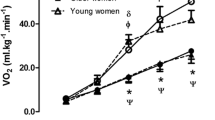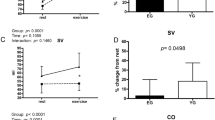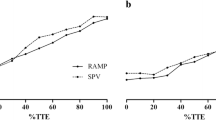Summary
Five older men (aged 60–69 yr) and five young men (aged 21–29 yr) with approximately equal levels of age-corrected\(\dot VO_2\) max were compared with respect to oxygen kinetics at equal absolute workloads (100 watts) and at equal relative workloads (45%\(\dot VO_2\) max) on a cycle ergometer. At 45%\(\dot VO_2\) max, half times for\(\dot VO_2\) response to instantaneous transition from unloaded pedalling were 30.0 s and 27.4 s for old and young respectively (t=0.260,p<0.80). No significant differences were found in the\(\dot V_E\) response and by inference none existed in O2 extraction. Mean half times for heart rate responses at a workload of 100 W were 24.2 s and 20.6 s for old and young groups respectively (t=0.722,p<0.49). Mechanical efficiency estimated from steady state data at 100 W was 19.8% and 20.5% for old and young groups respectively (t=0.574). The close similarity in responses to submaximal work in old and young subjects of equivalent fitness suggests caution in the interpretation of agewise decrements observed in physiological variables which may be sensitive to physical fitness status.
Similar content being viewed by others
References
åstrand I (1960) Aerobic work capacity in men and women with special reference to age. Acta Physiol Scand [Suppl] 49: 169
Beaver WL, Wasserman K (1968) Transients in ventilation at start and end of exercise. J Appl Physiol 25: 390–399
Berg WE (1947) Individual differences in respiratory gas exchange during recovery from moderate exercise. Am J Physiol 149: 597–610
Carpenter TM (1948) Tables, factors and formulas for computing respiratory exchange and biological transformations of energy. Carnegie Institution of Washington Publication 303C
Casaburi R, Whipp BJ, Wasserman K, Beaver WL, Koyal SN (1977) Ventilatory and gas exchange dynamics in response to sinusoidal work. J Appl Physiol 42: 300–311
Cerretelli P, Sikand R, Fahri LE (1966) Readjustments in cardiac output and gas exchange during the onset of exercise and recovery. J Appl Physiol 21: 1345–1350
Davies CTM (1968) Cardiac frequency in relation to aerobic capacity for work. Ergonomics 11: 511–526
deVries HA (1970) Physiological effects of an exercise training regimen upon men aged 52–88. J Gerontol 25: 325–336
deVries HA, Adams GM (1972) Comparison of exercise responses in old and young men: II ventilatory mechanics. J Gerontol 27: 349–352
Diamond LB, Casaburi R, Wasserman K, Whipp BJ (1977) Kinetics of gas exchange and ventilation in transitions from rest or prior exercise. J Appl Physiol 43: 704–708
Finch CE (1977) Guest editorial. J Gerontol 32: 257
Fujihara Y, Hildebrandt J, Hildebrandt JR (1973) Cardiorespiratory transients in exercising man. II linear models. J Appl Physiol 35: 68–76
Henry FM (1951) Aerobic O2 consumption and alactic debt in muscular work. J Appl Physiol 3: 427–438
Karlsson H, Londborg B, Linnarson D (1975) Time course of pulmonary gas exchange and heart rate changes in supine exercise. Acta Physiol Scand 95: 328–340
Linnarson D (1974) Dynamics of pulmonary gas exchange and heart rate changes at start and end of exercise. Acta Physiol Scand 415: 1–68
Margaria R, Mangili F, Cuttica F, Cerretelli P (1965) The kinetics of the oxygen consumption at the onset of muscular exercise in man. Ergonomics 8: 49–54
Pearce DH, Milhorn HT (1977) Dynamic and steady-state respiratory responses to bicycle exercise. J Appl Physiol 42: 959–967
Robinson S (1938) Experimental studies of physical fitness in relation to age. Arbeitsphysiologie 10: 251–323
Strandell T (1964) Heart rate, arterial lactate concentration and oxygen uptake during exercise in old men compared with young men. Acta Physiol Scand 60: 197–216
Whipp BJ (1971) Rate constant for the kinetics of oxygen uptake during light exercise. J Appl Physiol 30: 261–263
Whipp BJ, Wasserman K (1972) Oxygen uptake kinetics for various intensities of constant-load work. J Appl Physiol 33: 351–356
Wigertz O (1970) Dynamics of ventilation and heart rate in response to sinusoidal workload in man. J Appl Physiol 29: 208–218
Author information
Authors and Affiliations
Rights and permissions
About this article
Cite this article
deVries, H.A., Wiswell, R.A., Romero, G. et al. Comparison of oxygen kinetics in young and old subjects. Europ. J. Appl. Physiol. 49, 277–286 (1982). https://doi.org/10.1007/BF02334076
Accepted:
Issue Date:
DOI: https://doi.org/10.1007/BF02334076




